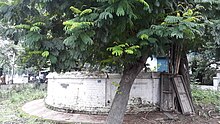Maharaja Nandakumar
Maharaja Nandakumar (also known as Nuncomar) (1705 – died 5 August 1775) was an Indian tax collector for various regions in what is modern-day West Bengal. Nanda Kumar was born at Bhadrapur, which is now in Birbhum. He was the first Indian to be executed by hanging. Nandakumar was appointed by the East India Company to be the Dewan (tax collector) for Burdwan, Nadia and Hooghly in 1764, following the removal of Warren Hastings from the post.[1]
In 1773, when Hastings was reinstated as governor-general of Bengal, Nandakumar brought accusations against him of accepting or giving bribes that were entertained by Sir Philip Francis and the other members of the Supreme Council of Bengal. However, Hastings overruled the council's charges. Thereafter, in 1775, he brought charges of document forgery against Nandakumar. The Maharaja was tried under Elijah Impey, India's first Chief Justice, and friend of Warren Hastings, was found guilty, and hanged in Kolkata on 5 August 1775.
Later Hastings, along with Sir Elijah Impey, the chief justice, was impeached by the British Parliament for committing judicial murder, but was eventually found not guilty.
Early life
Nandkumar was born in a Brahmin family. He held posts under Nawab of Bengal. After the Battle of Plassey, he was recommended to Robert Clive for appointment as their agent to collect revenues of Burdwan, Nadia and Hooghly.[2] The title "Maharaja" was conferred on Nandakumar by Shah Alam II in 1764.[1] He was appointed Collector of Burdwan, Nadia, and Hugli by the East India Company in 1764, in place of Warren Hastings. He learnt Vaishnavism from Radhamohana Thakura.[1][3]
Charges against Hastings
Maharaja Nandakumar accused Hastings of bribing him with more than one-third of a million rupees and claimed that he had proof against Hastings in the form of a letter.[4][3]
Hanging

Warren Hastings was then with the East India Company and happened to be a school friend of Sir Elijah Impey. Some historians are of the opinion that Maharaja Nandakumar was falsely charged with forgery and Sir Elijah Impey, the first Chief Justice of Supreme Court in Calcutta, gave a false judgement to hang Nandakumar.[5][self-published source][better source needed] Nandakumar's hanging has been termed a judicial murder by certain historians.[5] Macaulay also unsuccessfully accused both men of conspiring to commit a judicial murder at an impeachment trial.[5] Maharaja Nandakumar was hanged at Calcutta, near present-day Vidyasagar Setu, on 5 August 1775.[6] During that period the punishment for forgery was hanging (as mandated by the Forgery Act 1728 passed by the British parliament), although some legal scholars have said that the law was only applicable in Britain and not British territories in India.[7][3]
Books
- Sir James Stephen, The story of Nuncomar and the impeachment of Sir Elijah Impey (2 vols., 1885)
- Beveridge, Henry (1886). The Trial of Maharaja Nanda Kumar: A Narrative of a Judicial Murder. Calcutta: Thacker, Spink and Co.
Legacy
- A school in his honor, Bhadrapur Maharaja Nanda Kumar High School, was established on his birthplace at Bhadrapur village on Birbhum District.
- A temple was established by him on Akalipur Village near Bhadrapur village. The temple was built for Hindu deity Ma Kaali.This is a very popular temple and thousands of visitors came by. It is situated near the banks of the Brahmani River.
- A college in his honor, Maharaja Nandakumar Vidyalaya, was established in purba medinipur in 2007, and the college is affiliated with Vidyasagar University.[8]
- A road in Baranagar, Kolkata is named Maharaja Nandakumar Road.[9]
- Nandakumar is also the name of a locality in the West Bengal district of East Midnapur.[10]
- Nandakumar was established in Tamluk–Digha branch line of Kharagpur railway division.


In popular culture
Films and television
- In 1988, Doordarshan Serial Bharat Ek Khoj produced and directed by Shyam Benegal also picturised a full one episode on the Company Bahadur. In that titular role of Maharaja Nandakumar was played by noted television actor Rajendra Gupta.
External links
- The story of Nuncomar and the impeachment of Sir Elijah Impey Cornell University Library Historical Monographs Collection. {Reprinted by} Cornell University Library Digital Collections
- This article incorporates text from a publication now in the public domain: Chisholm, Hugh, ed. (1911). "Nuncomar". Encyclopædia Britannica (11th ed.). Cambridge University Press.
- Charges against Sir Elijah Impey
References
- ^ a b c "The Kunjaghata Raj family". Murshibad.net. Retrieved 10 June 2013.
- ^ "Hanging of Nanda Kumar | KolkataOnWheels". Archived from the original on 2019-02-06. Retrieved 2018-11-18.
- ^ a b c Lion Feuchtwanger und Bertolt Brecht, Lion Feuchtwanger (1927). Kalkutta, 4. Mai: drei Akte Kolonialgeschichte. Dr.PLISCHKA Hans Peter. p. 12.
- ^ Barbara Harlow, Edited by Mia Carter (2003). From the East India Company to the Suez Canal. Durham, North Carolina [u.a.]: Duke Univ. Press. p. 132. ISBN 9780822331643.
{cite book}:|first=has generic name (help) - ^ a b c Bhattacharya, Asim (2010). Portrait of a Vancouver Cabbie. USA: Xlibris Corporation. p. 141. ISBN 9781456836078.[self-published source]
- ^ Mandal, Sanjay (9 November 2005). "History that hangs fire – Nandakumar neglect". The Telegraph (Calcutta). Archived from the original on June 24, 2013. Retrieved 10 June 2013.
- ^ The History of Court by Prof. Pithawala
- ^ "Affiliated Colleges". Vidyasagar University. Archived from the original on 25 February 2012. Retrieved 12 June 2013.
- ^ Your local guide. "INDRANI DUTTA KALA NIKETAN IN MAHARAJA NANDAKUMAR ROAD". Bharat Desi. Retrieved 12 June 2013.
- ^ "Floods result in epidemic threat". The Statesman. 20 October 2013. Archived from the original on 23 October 2013. Retrieved 22 October 2013.